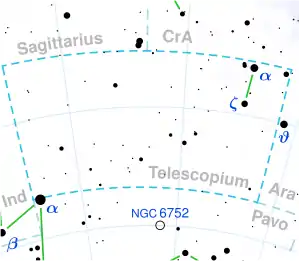HD 189080
HD 189080, also known as HR 7621 or rarely 74 G. Telescopii, is a solitary orange-hued star located in the southern constellation Telescopium. It has an apparent magnitude of 6.18,[2] placing it near the limit for naked eye visibility. Gaia DR3 parallax measurements place it at a distance of 357 light years [1] and it is currently receding rapidly with a heliocentric radial velocity of 66.9 km/s.[6] At its current distance, HD 189080's brightness is diminished by 0.17 magnitudes due to extinction from interstellar dust.[14] It has an absolute magnitude of +1.1.[7]
 | |
| Observation data Epoch J2000.0 Equinox J2000.0 (ICRS) | |
|---|---|
| Constellation | Telescopium |
| Right ascension | 20h 00m 25.32793s[1] |
| Declination | −49° 21′ 03.4019″[1] |
| Apparent magnitude (V) | 6.18±0.01[2] |
| Characteristics | |
| Evolutionary stage | red giant branch[3] |
| Spectral type | K0 III[4] |
| U−B color index | +0.92[5] |
| B−V color index | +1.06[5] |
| Astrometry | |
| Radial velocity (Rv) | 66.9±0.4[6] km/s |
| Proper motion (μ) | RA: −77.932 mas/yr[1] Dec.: −2.298 mas/yr[1] |
| Parallax (π) | 9.1277 ± 0.0321 mas[1] |
| Distance | 357 ± 1 ly (109.6 ± 0.4 pc) |
| Absolute magnitude (MV) | +1.10[7] |
| Details | |
| Mass | 1.19+0.16 −0.29[8] M☉ |
| Radius | 9.9±0.5[9] R☉ |
| Luminosity | 43.6±1.0[10] L☉ |
| Surface gravity (log g) | 2.46+0.09 −0.10[8] cgs |
| Temperature | 4,742±49[10] K |
| Metallicity [Fe/H] | −0.11±0.03[10] dex |
| Rotational velocity (v sin i) | <1[11] km/s |
| Age | 4.83+2.53 −3.22[8] Gyr |
| Other designations | |
| Database references | |
| SIMBAD | data |
This is an evolved red giant with a stellar classification of K0 III.[4] It is currently on the red giant branch,[3] fusing a hydrogen shell around an inert helium core. It has 119% the mass of the Sun, but at the age of 4.83 billion years[8] it has expanded to 9.9 times the radius of the Sun.[9] It radiates 43.6 times the luminosity of the Sun from its enlarged photosphere at an effective temperature of 4,742 K.[10] HD 189080 is slightly metal deficient with [Fe/H] = −0.11[10] and spins too slowly to be measured accurately.[11]
References
- Vallenari, A.; et al. (Gaia collaboration) (2023). "Gaia Data Release 3. Summary of the content and survey properties". Astronomy and Astrophysics. 674: A1. arXiv:2208.00211. Bibcode:2023A&A...674A...1G. doi:10.1051/0004-6361/202243940. S2CID 244398875. Gaia DR3 record for this source at VizieR.
- Høg, E.; Fabricius, C.; Makarov, V. V.; Urban, S.; Corbin, T.; Wycoff, G.; Bastian, U.; Schwekendiek, P.; Wicenec, A. (March 2000). "The Tycho-2 catalogue of the 2.5 million brightest stars". Astronomy and Astrophysics. 355: L27–L30. Bibcode:2000A&A...355L..27H. ISSN 0004-6361.
- Jones, M. I.; Jenkins, J. S.; Rojo, P.; Melo, C. H. F. (December 2011). "Study of the impact of the post-MS evolution of the host star on the orbits of close-in planets: I. Sample definition and physical properties⋆⋆⋆". Astronomy & Astrophysics. 536: A71. arXiv:1110.6459. Bibcode:2011A&A...536A..71J. doi:10.1051/0004-6361/201117887. ISSN 0004-6361.
- Houk, Nancy (1978). Michigan catalogue of two-dimensional spectral types for the HD stars: Declinations −53° to −40°. Vol. 2. Bibcode:1978mcts.book.....H.
- Oja, T. (1970). "UBV-Fotometri danska Tel (ESO)". Private Communication: 0. Bibcode:1970Priv.........0O.
- Gontcharov, G. A. (November 2006). "Pulkovo Compilation of Radial Velocities for 35,495 Hipparcos stars in a common system". Astronomy Letters. 32 (11): 759–771. arXiv:1606.08053. Bibcode:2006AstL...32..759G. doi:10.1134/S1063773706110065. eISSN 1562-6873. ISSN 1063-7737. S2CID 119231169.
- Anderson, E.; Francis, Ch. (May 2012). "XHIP: An extended hipparcos compilation". Astronomy Letters. 38 (5): 331–346. arXiv:1108.4971. Bibcode:2012AstL...38..331A. doi:10.1134/S1063773712050015. eISSN 1562-6873. ISSN 1063-7737. S2CID 119257644.
- Soto, M. G.; Jones, M. I.; Jenkins, J. S. (March 2021). "SPECIES. II. Stellar parameters of the EXPRESS giant star sample". Astronomy & Astrophysics. 647: A157 (23). arXiv:2009.03371. Bibcode:2021A&A...647A.157S. doi:10.1051/0004-6361/202039357. eISSN 1432-0746. ISSN 0004-6361. S2CID 221534230.
- Kervella, P.; Thévenin, F.; Di Folco, E.; Ségransan, D. (October 2004). "The angular sizes of dwarf stars and subgiants. Surface brightness relations calibrated by interferometry". Astronomy & Astrophysics. 426 (1): 297–307. arXiv:astro-ph/0404180. Bibcode:2004A&A...426..297K. doi:10.1051/0004-6361:20035930. eISSN 1432-0746. ISSN 0004-6361. S2CID 6077801.
- Ottoni, G.; Udry, S.; Ségransan, D.; Buldgen, G.; Lovis, C.; Eggenberger, P.; Pezzotti, C.; Adibekyan, V.; Marmier, M.; Mayor, M.; Santos, N. C.; Sousa, S. G.; Lagarde, N.; Charbonnel, C. (January 2022). "CORALIE radial-velocity search for companions around evolved stars (CASCADES): I. Sample definition and first results: Three new planets orbiting giant stars". Astronomy & Astrophysics. 657: A87. arXiv:2201.01528. Bibcode:2022A&A...657A..87O. doi:10.1051/0004-6361/202040078. eISSN 1432-0746. ISSN 0004-6361.
- De Medeiros, J. R.; Alves, S.; Udry, S.; Andersen, J.; Nordström, B.; Mayor, M. (January 2014). "A catalog of rotational and radial velocities for evolved stars V: Southern stars *". Astronomy & Astrophysics. 561: A126. arXiv:1312.3474. Bibcode:2014A&A...561A.126D. doi:10.1051/0004-6361/201220762. eISSN 1432-0746. ISSN 0004-6361. S2CID 54046583.
- Gould, Benjamin Apthorp (1878). "Uranometria Argentina : brillantez y posicion de las estrellas fijas, hasta la septima magnitud, comprendidas dentro de cien grados del polo austral : con atlas". Resultados del Observatorio Nacional Argentino. 1. Bibcode:1879RNAO....1.....G.
- "HD 189080". SIMBAD. Centre de données astronomiques de Strasbourg. Retrieved February 27, 2023.
- Gontcharov, George A.; Mosenkov, Aleksandr V. (28 September 2017). "Verifying reddening and extinction for Gaia DR1 TGAS main sequence stars". Monthly Notices of the Royal Astronomical Society. 472 (4): 3805–3820. arXiv:1709.01160. Bibcode:2017MNRAS.472.3805G. doi:10.1093/mnras/stx2219. eISSN 1365-2966. ISSN 0035-8711.